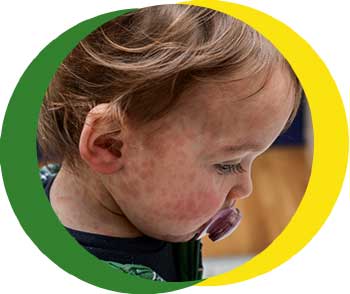Rashes

Skin rashes are common in babies and children.
- Most rashes are harmless and go away on their own
- The causes of skin rashes tend to differ in babies compared to older children. Many viruses can cause a rash in addition to other symptoms such as fever and cough.
- The rash often varies in shape and size, usually appearing as blotchy red spots commonly affecting most of the body. They sometimes appear quite quickly and usually last for only a few days. These rashes are generally ‘non-specific’, which means that it is often hard to say which specific virus is the cause.
Watch a video from Best Beginnings on common skin rashes:
When should you worry?
If your child has any of the following features:
- Is going blue around the lips
- Too breathless to talk / eat or drink
- Becomes pale, mottled and feels abnormally cold to touch
- Becomes extremely agitated (crying inconsolably despite distraction),
- Is confused or very lethargic (difficult to wake)
- Develops a rash that does not disappear with pressure (the ‘Glass Test’)
- Develops swollen lips, a swollen tongue and is struggling to breathe
- Is under 3 months of age with a temperature of 38°C / 100.4°F or above (unless fever in the 48 hours following vaccinations and no other red or amber features)
You need urgent help
Go to the nearest Hospital Emergency (A&E) Department or phone 999
If your child has any of the following features:
- Develops a painful rash
- Develops a blistering rash (unless has contact with chickenpox)
- Develops a rash affecting more that 90% of their body
- Has had chickenpox in the past few days and is now getting more unwell with a high fever and spreading red rash
- Develops red lips or a red tongue
- Develops significant skin peeling
- Is 3-6 months of age with a temperature of 39°C / 102.2°F or above (but fever is common in babies up to 2 days after they receive vaccinations)
- Continues to have a fever of 38.0°C / 100.4°F or more for more than 5 days
You need to contact a doctor or nurse today
Please ring your GP surgery or call NHS 111 – dial 111
We recognise that during the current COVID-19 crisis, at peak times, access to a health care professional may be delayed. If symptoms persist for 4 hours or more and you have not been able to speak to either a member of staff from your GP practice or to NHS 111 staff, then consider taking them to your nearest Emergency Department
- If none of the above features are present, most children with fever and rash can be safely managed at home
- If you think that this is a worsening of your child’s eczema, optimise your child’s eczema treatment or see their GP or practice nurse
- Additional advice is also available to young families for coping with crying of well babies – click here
Self care
Continue providing your child’s care at home. If you are still concerned about your child, call NHS 111 – dial 111
What should you do?
- Some rashes require no medical input and simply get better by themselves without any treatment. This includes viral rashes. If your child has a fever, you may want to lower their temperature using paracetamol (calpol) and/or ibuprofen as per the instructions on the packaging
- Some rashes require you to keep your child off from nursery or school. This includes chickenpox and scarlet fever
However, certain conditions such as eczema and impetigo require treatment from your GP.
Common rashes
For information on common rashes in babies and infants
For information on common rashes in older children
Where should you seek help?
- If it is non-urgent, speak to your local pharmacist or health visitor.
- If your child has any of the above features, urgently see your GP. For an urgent out-of-hours GP appointment, call NHS 111.
- You should only call 999 or go your nearest A&E department in critical or life threatening situations.

